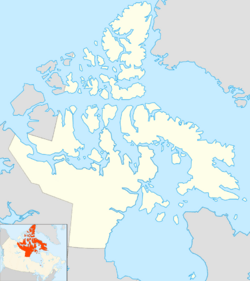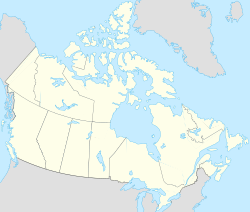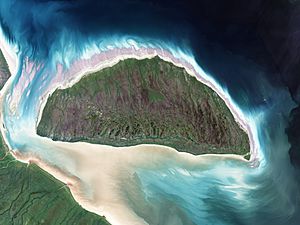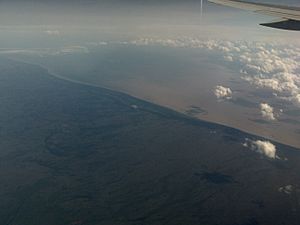Akimiski Island facts for kids
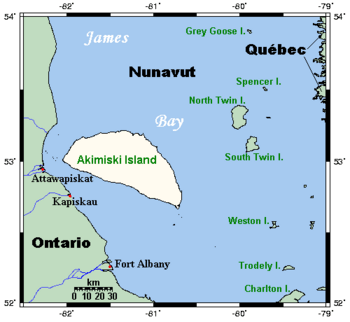
Closeup of Akimiski Island
|
|
| Geography | |
|---|---|
| Location | Nunavut |
| Coordinates | 53°00′30″N 081°16′30″W / 53.00833°N 81.27500°W |
| Archipelago | Arctic Archipelago |
| Area | 3,001 km2 (1,159 sq mi) |
| Highest elevation | 34 m (112 ft) |
| Administration | |
|
Canada
|
|
| Territory | Nunavut |
| Region | Qikiqtaaluk |
| Demographics | |
| Population | Uninhabited |
Akimiski Island is the largest island in James Bay, Canada. James Bay is a large part of Hudson Bay. This island is located in the Qikiqtaaluk Region of Nunavut.
Akimiski Island covers an area of 3,001 km2 (1,159 sq mi). This makes it the 163rd largest island in the world. It is also Canada's 29th largest island. The island is only 19 km (12 mi) away from the province of Ontario. You can even see the Ontario coastline from the western side of Akimiski Island.
The name "Akimiski" comes from the Swampy Cree language. It means "land across the water."
No one lives on Akimiski Island all year round. However, it is an important traditional area for the Attawapiskat First Nation. They use the island for many traditional activities.
The island's surface is mostly flat. It gently slopes down towards the north. The plants that grow here include lichen, moss, sedges, and small black spruce trees. Akimiski Island is a coastal wetland. This means it has mudflats and marshes that are covered by water at high tide. Rivers flowing into James Bay bring lots of nutrients. These nutrients help many birds and other animals thrive around the island.
The Akimiski Island Group includes Akimiski Island itself. It also has Gasket and Gullery islands, Albert Shoal, and the Akimiski Strait Isles.
Contents
What is the Climate Like on Akimiski Island?
The weather on Akimiski Island is quite cold. Here are some facts about its climate:
- The average temperature each year is about 2.5 °C (36.5 °F).
- It usually gets about 450 mm (17.72 in) of rain each year.
- The island receives about 25 cm (9.84 in) of snow annually.
Why is Akimiski Island Important for Nature?
Akimiski Island is a very special place for nature. It is home to the Akimiski Island Migratory Bird Sanctuary. This sanctuary is a Canadian Important Bird Area. It is known as site #NU036 (53°10′12″N 081°19′48″W / 53.17000°N 81.33000°W).
The eastern part of the island is also a federal Migratory Bird Sanctuary. Much of its coastline is a Key Migratory Bird Terrestrial Habitat site. This means it's a crucial spot for birds.
What Animals Live on Akimiski Island?
The coastal waters and wetlands around Akimiski Island are important feeding areas. Many types of migratory birds stop here. These birds travel long distances each year.
Some of the birds you might see include:
James Bay and Hudson Bay are shaped like a funnel. This shape causes migrating birds from the Arctic to gather in this area. In the fall, many adult and young birds are present. In the spring, birds often stay in the southern parts of James Bay. They wait there until the northern areas melt.
Besides birds, you can also find some amazing mammals in the area. These include ringed seals, polar bears, and beluga whales.
See also
 In Spanish: Isla Akimiski para niños
In Spanish: Isla Akimiski para niños


